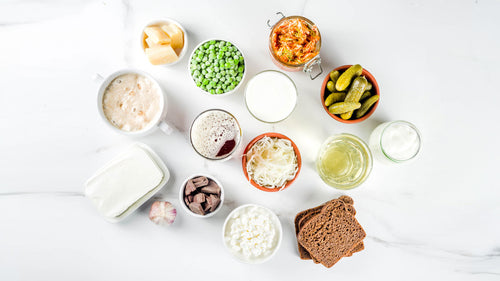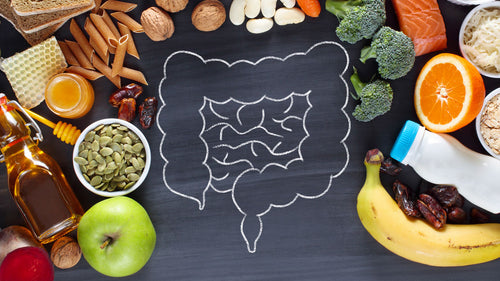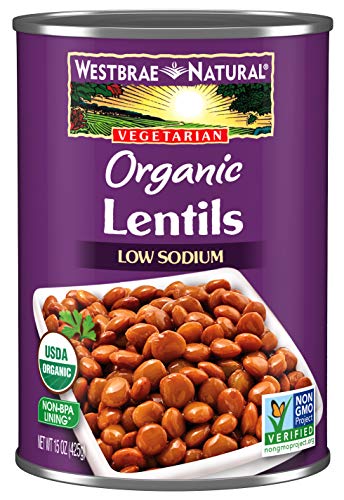
Navigating the Grocery Store with Gut Health in Mind
Published on Tuesday, April 02, 2024 by Lindsey LemusConnecting the Grocery Store and Your Gut
Recognizing gut-friendly foods or putting together a meal that promotes digestive wellness is a challenge! The first place to start identifying gut-healthy foods is the grocery store, which can be intimidating, especially on a budget. Luckily, we have several tricks and tips for successfully putting together gut-friendly meals when you’re thinking about your weekly groceries.
Fruits and Vegetables and Nuts and Seeds, Oh My!
Fruits and vegetables are a great place to start your grocery-gut-health journey. They have fiber and prebiotics and can be added to your favorite dishes to bring a dash of diversity to your plate. If you are looking for an economical way to increase fruits and vegetables in your diet, don’t forget to check the frozen aisles. Picked and frozen at peak ripeness and nutrient availability, frozen fruits and vegetables are a smart and savvy way to treat your gut [and your wallet] well.
Canned fruits and vegetables are also a cost-effective and great choice when thinking about how to add color to your meals. Make sure to check the nutrition label and choose canned fruits and vegetables without added sugar.
Nuts and seeds are not only a vitamin and mineral treasure trove but are also high in nutrients (such as fiber) that act as prebiotics in the body, feeding the good bacteria in your gut. Generally found in the baking or snack aisles, nuts and seeds may be tricky to find and even trickier to purchase on a budget since they are often seen as expensive snacks. Buying nuts in bulk is often the best bang for your buck and is priced cheaper. If buying in bulk is not an option, buying nuts and seeds from store brands over name-brand is another economical option.
Finding Fiber-Rich Foods For Your Pantry:
Stocking up on beans, lentils, and whole grain pastas is a great way to ensure gut-friendly foods are at home when needed. You can buy canned or dried (requires cooking) beans as a great source of protein and fiber, providing 7 grams of protein and 5 grams of fiber per serving to help keep you full and your gut microbes happy. Opt for low-sodium canned beans if you are concerned about heart health, or you can rinse off canned beans in a colander to remove excess sodium. Canned beans are also an effective way to add protein and fiber to your meals without affecting your budget.
As a nutritional powerhouse, lentils provide nutrients like iron, magnesium, B vitamins, and folate and are excellent sources of protein and fiber—18 grams of protein and 15 grams of fiber! Buy them canned or dried (requires cooking) and add them to soups and salads, or even add them to hamburger meat to make a fiber-rich, plant-focused burger. Canned lentils are an affordable plant-based protein option.
Be Dazzled by Dairy:
Fermented dairy products like kefir and yogurt contain gut-friendly probiotics that contribute to gut health and can help digestion. Other fermented dairy products like buttermilk, sour cream, and certain cheeses like ricotta and cottage cheese also contain a variety of probiotics that can easily be added to your daily nutritional regimen.
Fermented dairy products are also often easier to digest for lactose-intolerant folks because the live cultures in these products are fed from the lactose sugars, decreasing lactose in the product. Try swapping kefir for milk in your smoothies, including cottage cheese in your protein pancake recipe, or adding an extra spoonful of Greek yogurt to your overnight oats for some microbiome magic.
Spice Up Your Life.
Did you know that some spices are great for gut health and can play an incredible role in a gut-healthy, anti-inflammatory diet? Some research on spices like turmeric, ginger, cinnamon, garlic, cayenne pepper, cardamom, and black pepper has shown that not only do many of these spices contain anti-inflammatory properties, but some also contain prebiotics that help aid in digestion and grow the beneficial bacteria in your gut. Check out these spices and season your grilled meats, soups, and side dishes with them. Buying spices in bulk can be a cost-effective way to add these functional foods to your weekly meals, especially if you use them for many dishes.
Label Investigator:
Finally, as you maneuver the aisles of the grocery store, it is important to have a good understanding of nutrition labels in order to make informed decisions about eating for gut health. When choosing gut-friendly foods at the store, remember to be on the lookout for high amounts of sodium, added sugar, or saturated fats. The nutrition label is also the place to find how many grams of fiber a serving of your food product has, so make sure to check the fiber content of your purchases!
While food labels do not necessarily show the prebiotic or probiotic content of food products, fermented products like kefir, yogurt, kombucha, and tempeh may state on the product if they contain live cultures and the strain of probiotic species.
Conclusion: Making Informed Decisions For Your Gut
Most importantly, you’ll want to choose foods that YOU like and foods that fit YOUR budget. Eating for gut health may seem like a tricky task, but trying new foods or adding foods you already like to your favorite recipes can help you make small, sustainable changes that benefit your gut microbiome.
- Aryana, K. J., & Olson, D. W. (2017). A 100-Year Review: Yogurt and other cultured dairy products. Journal of dairy science, 100(12), 9987–10013. https://doi.org/10.3168/jds.2017-12981
- Dahl, S. M., Rolfe, V., Walton, G. E., & Gibson, G. R. (2023). Gut microbial modulation by culinary herbs and spices. Food chemistry, 409, 135286. https://doi.org/10.1016/j.foodchem.2022.135286
- Dahl, W. J., & Stewart, M. L. (2015). Position of the Academy of Nutrition and Dietetics: Health Implications of Dietary Fiber. Journal of the Academy of Nutrition and Dietetics, 115(11), 1861–1870. https://doi.org/10.1016/j.jand.2015.09.003
- Ganesan, K., & Xu, B. (2017). Polyphenol-Rich Lentils and Their Health Promoting Effects. International journal of molecular sciences, 18(11), 2390. https://doi.org/10.3390/ijms18112390
- Mullins, A. P., & Arjmandi, B. H. (2021). Health Benefits of Plant-Based Nutrition: Focus on Beans in Cardiometabolic Diseases. Nutrients, 13(2), 519. https://doi.org/10.3390/nu13020519
Good helpful information
Great article Lindsey.
Leave a comment on this article:
-
Lindsey Lemus
Ph.D. Student

Nurturing Your Gut: Practical Tips for a Healthy Microbiome

Plant-Based Eating on a Budget: Tips for Affordable and Nutritious Meals

Mastering Gut Health: How Diet Influences Your Microbiome

Digital Detox Guide: Unplug and Recharge for Happiness

Conquering Common Age-Related Gut Changes with Smart Food Choices

Springtime Wellness: Coping with Allergies, GERD, and IBS





